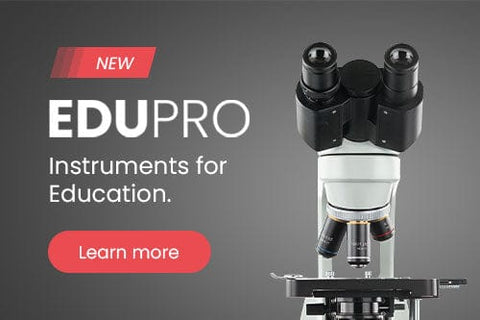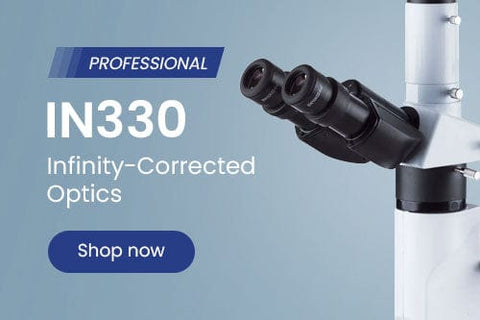- Microscopes
- Cameras
- Lab Supplies & Equipment
- Shop By Brand
- Lab Supplies by Category
- Analyzer Consumables
- Balances
- Bags
- Beakers
- Bench Scale Bases
- Bottles
- Bottletop Burettes
- Bottletop Dispensers
- Boxes
- Blank Microscope Slides & Cover Slips
- Blood Collection
- Caps
- Carboys
- Centrifuges
- Centrifuge Tubes
- Cold Storage
- Containers
- Cryogenic Vials
- Culture Tubes
- Cylinders
- Dispensers
- Digital Dry-Baths
- ESR Products
- False Bottom Tubes
- Flat Bottom
- Funnels
- Gel Documentation
- Glassware
- Glass Test Tubes
- Histology
- Homogenizers
- Hotplates-Stirrers
- Inoculation Loops and Spreaders
- Liquid Handling Products
- Manual-Electronic Pipettors-Pipettes
- Microscope Slides
- Overhead Stirrers
- Pipette Controller (Serological Filller)
- Pipette Tips
- Plastic Test Tubes
- PCR Tubes, Strips & Plates
- Racks
- Repeater Pipettor
- Rockers
- Rotary Evaporators
- Serological Pipettes
- Shakers
- Spectrophotometers
- Syringe Tips
- Sample Tubes
- School/Classroom Supplies
- Screwcap Test Tubes
- Self-Standing
- Test Tube Racks
- Test Tubes & Vials
- Transport & Storage Tubes
- Thermal Mixers
- Transfer Pipets
- Urinalysis
- Vacuum Pumps
- Weighing Dishes
- Lab Equipment
- Balances
- Bench Scale Bases
- Centrifuges
- Digital Dry-Baths
- Gel Documentation
- Homogenizers
- Hotplates-Stirrers
- Overhead Stirrers
- Pipettors
- Rockers
- Rotary Evaporators
- Shakers
- Serological Pipettes
- Spectrophotometers
- Thermal Mixers
- Vacuum Pumps
- Liquid Handling Products
- Manual-Electronic Pipettors-Pipettes
- Pipette Tips
- Racks
- Pipette Fillers-Controllers
- Repeater Pipettor
- Syringe Tips

Cost effective products and solutions designed to improve laboratory efficiency, safety and results.
SHOP BENCHMARK SCIENTIFIC >
- Slides & Accessories
- Slides
- Cameras
- Illuminators
- Adapters
- Eyepieces / Objectives
- Bulbs
- Magnifying Lamps
- Monitors and Tablets
- View All Categories
- Adapters
- DSLR Adapters
- USB Camera Adapters
- Ring Light Adapters
- Power Adapters
- Barlow Lens
- Books & Experiments Cards
- Bags & Cases
- Bags
- Cases
- Cameras
- Circuit Board Holders
- Cleaning Kits
- Condensers
- Darkfield
- Phase Contrast Kits
- Polarizing Kits
- Dust Covers
- Eye-Guards
- Eyepieces
- 20mm
- 23mm
- 30mm
- 30.5mm
- Filters
- Microscope Filters
- Illuminator Filters
- Fluorescence Kits
- Conversion Kits
- Filter Cubes
- Focusing Racks
- Fuses
- Illuminators
- Bulbs
- LED Illuminators
- Fiber Optic Illuminators
- Fluorescent Illuminators
- Ring Lights
- Stand Lights
- Goosenecks
- Gooseneck Attachments
- Immersion Oils
- Loupes
- Magnifying Lamps
- Clamp Lamps
- Desktop Lamps
- Rolling Stand Lamps
- Mechanical Stages
- Monitors and Tablets
- Calibration Slides & Stage Micrometers
- Stage Warmers
- Stain Kits
- Stands
- Articulating Arm Stands
- Boom Stands
- Table Stands
- Tweezers
- Other Accessories
- Shop By Industry
- Shop By Industry
- Botany
- Agronomy & Forestry
- Horticulture
- Phytopathology
- Chemistry
- Biochemistry
- Biotechnology
- Cannabis
- Pharmaceutics
- Consumables
- Beer & Wine
- Cosmetics
- Food & Beverage
- Electronics
- Circuit Boards & General Electronics
- Mobile Phone Repair
- Semiconductors & Wafers
- Environmental
- Asbestos
- Ecosystem Research
- Mud Logging
- Soil Treatment
- Water Treatment
- Forensics
- Ballistics
- Fingerprint Analysis
- Genetic Identification
- Hair & Fiber Analysis
- Handwriting Analysis
- Industrial
- Aerospace
- Automotive
- Dental Lab & Production
- Glass Industry
- Industrial Inspection
- Mechanical Parts
- Paper Industry
- Petrochemical
- Plastics
- Printing Industry
- Quality Assurance & Failure Analysis
- Textiles & Fibers
- Tool Making
- Wood Production
- Jewelry & Gemology
- Engraving
- Gemology
- Jewelry Repair
- Stone Setting
- Watch Repair
- Hobby
- Coins & Collecting
- Stamps
- Modeling & Assembly
- Sculpting
- Repair
- Telescopes
- Metallurgy
- Archaeology
- Geology
- Mining
- Petrology
- Medical & Microbiology
- Anatomopathology
- Bacteriology
- Biochemistry
- Cell Culture
- Cytology
- Dental Microbiology
- Dermatology
- Dissection
- Gout & Rheumatology
- Hair & Fiber Analysis
- Hair Transplant
- Fluorescence
- Hematology & Live Blood Analysis
- Histopathology
- Mycology
- Medical Devices
- Microsurgery
- Neuropathology
- Oncology
- Parasitology
- Pathology
- Semen Analysis
- Virology
- Veterinary & Zoology
- Breeding & Semen Analysis
- Entomology
- Fecal Smears & Floats
- Marine Biology
- Ornithology
- Veterinary Medicine
- Zoology
- Shop By Industry
- Students
- Telescopes
- Buy With Prime
- Sale
Explore The Gift Lab
- Compound Microscopes
- Shop By Brand
- AmScope
- Euromex
- Omax
- Shop by Head Type
- Binocular
- Monocular
- Trinocular
- Multi-head & Training
- Shop By Specialty
- Brightfield
- Darkfield
- Phase Contrast
- Inverted
- EPIfluorescence
- Polarizing
- Digital Integrated
- Metallurgical
- Shop By Application
- Education
- Research
- Veterinary
- Compound With Digital Head
- Shop Best Sellers
- Shop All Compound
- Stereo Microscopes
- Shop By Brand
- AmScope
- Euromex
- Shop By Objective Type
- Fixed Power
- Zoom Power
- Single Lens
- Common Main Objective
- Shop By Stand Type
- Articulating Arms
- Boom Stands
- Gooseneck Stands
- Table Stands
- Other Stands
- Shop By Head Type
- Binocular
- Monocular
- Trinocular
- Simul-Focal
- Shop By Industry
- Video Inspection
- Industrial Inspection
- Microscope Heads
- Shop Stands
- Articulating Arm
- Boom Stands
- Table Stands
- Stereo With Digital Head
- Shop Best Sellers
- Shop All Stereo
- Specialized Microscopes
- Digital Microscopes
- Kids, Student Microscopes
| AmScope Blogs
How Much Does It Cost to Run a Clinical Trial? The Ultimate Guide to Developing a Study Budget

The cost of running a clinical trial increases annually with the same certainty as death and taxes. In the early 2000s, the estimated costs of introducing a new drug to the market were around a mere $800 million. A daunting number, to be sure, but a fraction of the almost-three-billion dollars it can cost today.
Not all clinical trials are designed to bring a brand-new drug to market, so don’t let those numbers scare you completely away from science. However, whether your trial centers on observation and behavioral therapy or pharmaceutical development, the same basic steps are required to piece together a budget. This article explores the nuances of those steps in order to discuss the best ways for a lab to plan a trial without wasting hard-earned money.
Initiate Communication Early
One of the first steps in drawing up an accurate budget is to start talking early. Putting in the legwork for the initial budget well before its due date gives you ample time to talk to expert investigators and coordinators, and gets a well-rounded view of all the technology, equipment and participants that a study of your size will entail. Data monitoring, data management and statisticians can run up extra costs and fees, especially for larger trials.
Communicate with all players in the early days in order to avoid underestimating invoicing costs. It will help to lay out the full scope of work by answering some of the following questions:
-
Who is coordinating the trial and data?
-
What are their costs and expenses?
-
What are the per-patient costs of technology and travel?
-
How many patients are needed?
-
What are the recruiting costs per patient and for the coordinators?
-
What additional labs, imaging, etc. are required?

Data Collection
The primary goal of a clinical trial is to answer a clinical question. This is achieved by collecting data from different patients–often over and over again. No drug will ever be approved if the data is unclear or misrepresented. Collecting, storing and analyzing data is paramount to running an effective study. Efficient data collection programs and systems will allow your trial to run smoothly and remain cost-effective. Advanced technology is your friend in this scenario.
Updated electronic data software is key for reducing human error, from collection to storage. The right program can also cut labor costs by eliminating unnecessary steps along the way. Do your due diligence in researching your data collection software. You want software that more than one person in your lab can use and that ideally comes with a little training. Save time and money down the line by making sure whoever is in charge of data knows how to operate that software inside and out.
Jump on New Tech
Not only are new technologies necessary for data collection, but they can reduce human error across the board. There are few better examples of where technology can make or break a solution than in medical institutions. Everyone hopes to have the latest, greatest tech in the lab–from top-of-the-line medical microscopes to diagnostic imaging.
In the age of smartphones, however, healthcare can take the technology beyond the workspace and utilize certain apps for patient monitoring at home. Cardiology patients can monitor their heart rates at home, saving them travel time for extra clinical visits. Not only does this trim the fat from the travel budget, but it also eliminates the need to pay for extra staff for in-house follow-ups. There are even microsampling devices and programs that patients can use to take readings and collect data at home. This level of patient autonomy was not feasible in the past, but modern tech enables clinical trials to cut costs of superfluous office visits and even staff training.

Focus on Your Patients
For many people who are involved in a clinical trial, the opportunity for a new or safer treatment is enough to get them in the door. For others, home monitoring and minimal clinical follow-ups boost the likelihood of participation even more. Other patients, however, might feel less inspired to see a trial from start to finish, especially if the trial is particularly lengthy or complex. Patient-centric protocols lead to greater participation. A patient cohort who sticks to protocol throughout the entire study is paramount to a trial’s success. Consistent participation shortens the trial timeline, and can significantly help you stick to your budget by preventing your lab from having to go through the trouble of finding new patients.
Focusing on your patients goes beyond bedside manner and includes education and even translation. Patients who have a basic grasp of what’s happening in their bodies tend to have a higher level of confidence and willingness to engage. Patients who are able to read the study material and instructions in their native languages are also far more likely to adhere to the trial. Look for a good translation service ahead of time to cut back on problems down the road.
Have a Recruit Plan
A lot of studies lose time and money by failing to recruit enough participants. Due diligence into investigating recruiting processes can ensure your study gets enough recruits from the get-go. Larger trials may want to consider hiring someone to help them advertise in order to reach the targeted demographics.
This type of aggressive recruiting pre-trial will hopefully enable you to get an overflow of participants from the beginning, which can serve as a buffer or backup in case patients drop out along the way. Loss of patients mid-trial is not only frustrating but can lead to a massive hemorrhage of money. Time is money in the world of clinical trials, and the lengthier a timeline gets, the more money is needlessly lost.

Make Your Checklists
Your product and lab checklists should be done before you submit a proposed budget. Basic lab supplies required, like chemicals and glassware, can be mapped out in a spreadsheet to determine how much money you need to allot towards them.
However, pieces of equipment should also be tallied and inspected before you get going. Make sure all materials, microscope accessories, patient monitoring devices and even lab safety equipment are in prime working order. The last thing you’ll want to hear once your trial gets off the ground is that you have to repair a microscope or, even worse, send a patient home because a piece of medical equipment had an unexpected glitch. Especially if you will be using equipment that’s new to your lab or has been underutilized in recent years, it is recommended to run pre-checks and tests in case you need to budget for a surprise repair.
Sites and Infrastructure
Infrastructure is a huge part of every clinical trial. Especially if multiple sites need to coordinate on samples and data, underestimating your site budget can cause you to greatly exceed your projected budget. Trying to incorporate more sites down the line will always incur greater financial burden as well as extend the trial’s timeline.
Not only are longer studies more expensive for administrative reasons, but holding up clinical trials can actually shut them down altogether. For example, the National Institutes of Health (NIH) awards clinical trials based on fulfilled milestones. If projected milestones are not met in an amount of time deemed reasonable by the NIH, the entire study runs the risk of being shut down. Depending on the institution at which the trial takes place, it can take months to revise site and infrastructure issues.

The Devil Is in the Details
Misjudging simple things, like shipping costs, could hinder budget accuracy. As most lab managers are aware, human samples require jumping through several extra hoops before they reach their final destination. Hazmat costs, dry ice, CDC clearance and myriad other details must be accounted for before the budget is drawn up. Figure out the total shipping costs per patient per sample rather than estimating, since shipping costs and clearances change all the time. Make sure each employee affiliated with the trial is up to date on the required training and clearances to prevent setbacks or even non-compliance issues as the trial gets underway.
Safety Clearance
Does everyone in your lab have the appropriate safety clearance for his/her assigned task? If your trial spans multiple sites, especially if these sites are in more than one state or country, does everyone involved have the necessary permits? Clinical trials have some of the strictest regulations and administrative clearances seen in any institution, and exchanging data or samples across either domestic or international borders can produce a world of roadblocks and speed bumps. Before you draw up a trial budget, thoroughly investigate every training, permit and clearance required by each institution and funding entity to see who falls under those umbrellas. If extra training is required, be sure to include that in your proposed budget. It might add a little extra in the beginning, but it’s sure to save you trouble and money when it’s all said and done.
IRB Fees
The Institutional Review Board requires fees before it reviews any proposed clinical trial from a for-profit institution. If your lab is in a not-for-profit institution, you may still be subject to these fees if the project is fully or even partially supported by a for-profit institution. Different institutions require different levels and grades of fees. It is best practice to speak to a financial officer in your institution for a full run-down of IRB fees. However, they are usually charged for initial reviews and continuing reviews, with added fees for expediting deadlines.

Additional Travel Expenses
While small details like public transportation or parking fees for patients initially come to mind, all travel costs should be considered. Site visits for investigators and other lab members may be required for multi-site studies, where airfare and accommodations are in order. Long-term studies may require Investigator Meetings, or external reviews, where members from the lab present the data that has been collected and analyzed by pre-determined milestones. Conferences and symposia can even be considered for some budgets if presenting data to other institutions could help facilitate the trial or garner more funding in the future.
There is no shortage of details to worry about when piecing together the first draft of your clinical trial’s budget. With its multiple phases, approvals and enrollments, the budget can often take more time to write than the initial grant submission. Clinical trials in the United States are notoriously expensive, so even if it seems like an impossible task, it’s worth it in the end to outline every last tiny detail ahead of time to see where money can be saved and changes can be made. It’s a fine balance between making sure you don’t underestimate a budget and have to scramble for more funding later, and trying to avoid giving the funding institution sticker shock by outlining a budget that seems too high. As long as your requests are reasonable and straightforward, it’s best to cover all your bases from the get-go.
Free Shipping on orders $149+
Same day shipping for orders within the contiguous U.S.
Easy Returns
Hassle-free 30-day return policy. 100% satisfaction guarantee.
Quality Products
5-year warranty on AmScope microscopes.
Got a question?
Speak to our team of experts and find the products you need.
















